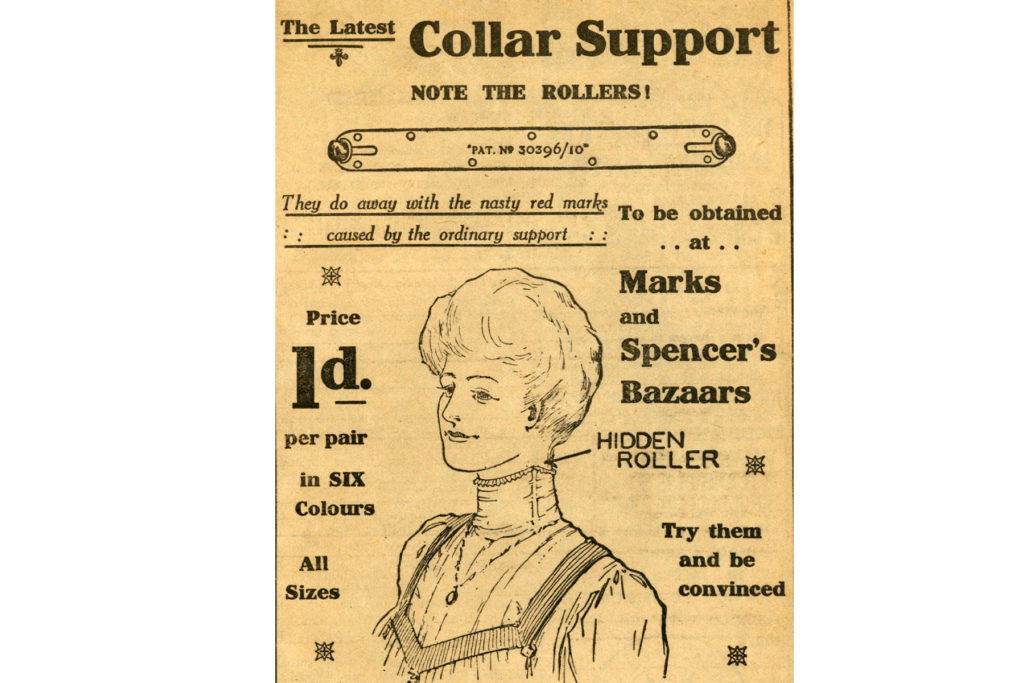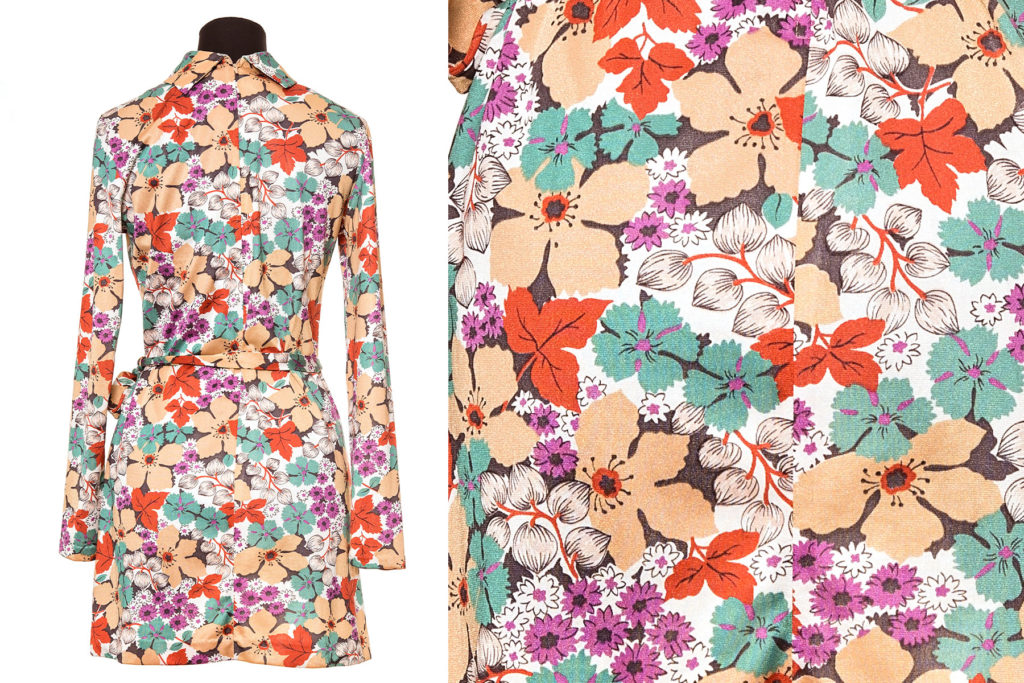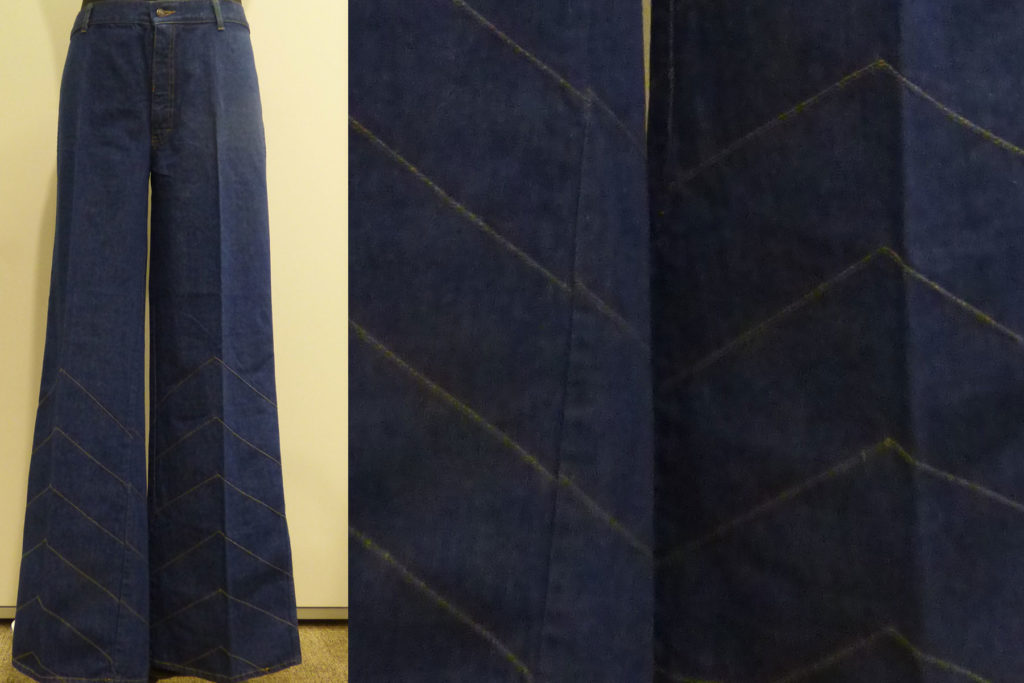Christmas closure: The Archive will be closed from 15 December to 2 January
Arguably the best high street fashion archive in the UK, our collection tells the story of M&S clothing from the 1920s onwards.
To make sure that the archive collection survives in the best possible condition, it’s stored in our temperature and climate controlled strong room.
Hanging garments are carefully packaged to protect them from light and everything has its own unique reference number. Smaller items, like gloves, hats and shoes, are wrapped in acid-free tissue paper and stored in boxes.
We try to show as many garments as we can at any one time in our archive exhibition, and the displays change regularly.
It’s not just the clothing that can be a fantastic source of inspiration, we also have examples of original packaging for garments and thousands of marketing images.
Michael Marks set up his first Penny Bazaar stall at Kirkgate Market in 1884, selling basic household items.
The majority of our customers wouldn’t have had the disposable income to buy clothing, so made and repaired their own clothes. Therefore we sold sewing equipment and haberdashery items such as needles, threads, hooks and eyes, yarns, buttons and replacement needles for sewing machines.
In 1894 Michael Marks went into partnership with Tom Spencer and the Marks & Spencer name was born. M&S expanded onto the high street and by the turn of the century there were 12 high street stores and 24 market stalls.
Our merchandise continued to include household essentials, sewing equipment and stationery – all laid out for customers to browse, rather than being kept behind a counter. There was no obligation to buy, and customers responded positively to this new, enjoyable, hands-on shopping experience created by M&S.

By 1908 both Michael Marks and Tom Spencer had died, and in 1916 Michael’s son Simon Marks took over the company.
Simon transformed the business in the 1920s and 1930s, introducing a new upper price limit of five shillings and a wider range of goods. Our drapery department opened in 1926 selling clothing, including the earliest bra in our collection which dates from the late 1920s.
In 1928 Simon created the sub-brand, St Michael, named in honour of his father. Initially it only appeared on items made to M&S specifications as a quality mark, but by the 1950s it had become the M&S own-brand, used on all products.
The archive contains a collection of staff bulletins which were weekly documents instructing store managers on new products, trading updates and merchandising techniques.
They tell us a huge amount about this period, including the start of visual merchandising and how our goods were displayed.
By the 1930s M&S was bringing mass-produced clothing to the high street.
We played a pioneering role in making fashion accessible, establishing our own in-house textile laboratory in 1935. Scientific methods were used to test the quality of fabrics and garments.
A dedicated Design department was set up at the same time. It was unusual for a mainstream retailer to have an in-house design team, our designers were committed to innovation and gave M&S an advantage over our competitors.
The increasing range of products in the 1930s required new display methods.
Panelled island counters were installed rather than traditional wall counters, creating central displays and providing useful storage for extra stock. Products were displayed by type, so all the skirts were arranged in one section, blouses in another and hats were displayed in stylish ‘hat bars’.
Most garments sold at this time were made from rayon artificial silk, wool or cotton. Art silk, as it was known, proved very popular as it created glamorous, flowing garments but was more affordable and easier to care for than real silk.



Accessible, practical clothing became more important during the Second World War.
In June 1941 clothes rationing began, with a coupon system based on the amount of fabric needed for each garment. M&S worked with the government to set specifications, in what became known as the Utility Clothing scheme, rolled out in 1942. Today we have one of the largest Utility clothing collections in the UK.
M&S departments designed bright, attractive prints for Utility Wear. Slacks for women were among the best-sellers, dressing gowns and Utility lingerie were popular too.
During the war, austerity measures were created to restrict the use of cloth, trimmings and pleats in clothing, a maximum of five buttons and two pockets were allowed. Skirt lengths and turn-ups on men’s trousers were also limited.
Austerity measures were relaxed after the war and the Utility scheme ended in 1952, with M&S carrying new knowledge of print technology and synthetic fabrics forward into the 1950s.
By the end of the 1950s the emphasis was on producing garments that were easy to wash and easy to wear.
Simon Marks saw the advances in textile technology made during the war as something to build on for customers, with the idea of making people’s lives easier.
At the forefront of this post-war transformation was a spun rayon fabric produced under the Utility scheme and known simply as Fabric 1005. By 1953 it had been rebranded as Marspun.
As nylon was no longer needed for military use it became readily available for clothing.
We made men’s shirts using blends of natural fibres with nylon, as well as women’s blouses and underwear. In 1954 we were using Terylene, an early form of polyester, for a wide variety of garments, whilst 1955 brought synthetic washable jersey onto the sales floor.
By focusing on specific easy-care properties such as drip-dry and minimum-iron we created clothing which was not only fashionable, but also freed people from the drudgery of laundry day.
Other new wonder fabrics of the 1950s included Tricel and Orlon which had a similar appearance to cashmere, and Agilon which was used to make breathable elasticated stockings.
By the 1950s M&S swimwear had evolved from 1930s woolen swimsuits and was making use of new synthetic fabrics.
Strapless swimsuits became fashionable and men didn’t miss out – swimming trunks with elasticated waists were big sellers.
The M&S stand at the 1962 Ideal Home Show sold as much swimwear in one day as an average store would sell in a week. The following year the stand included a dedicated swimwear bar to cope with demand, featuring styles like the classic Bri-nylon blue and white one-piece.
In the 1960s we drew attention to the versatility of the new generation of wonder fabrics such as Crimplene, Acrilan, Terylene and nylon with their easy-care, easy-wear properties.
Jerseywear was a St Michael staple made with Tricel and Ban-lon, and in 1960 and we suggested that jersey skirts could be cut to any length without hemming, as the fabric couldn’t ladder.
M&S created cinema adverts that reflected the style of Hollywood musicals with big sets, singing and dancing. Our latest St Michael fashions were showcased in various settings, from glamorous cocktail parties to sun-baked Mediterranean terraces.

Our archive collection reflects changes in society by recording what ordinary people chose to wear.
In the 1960s we launched ranges of women’s workwear – jersey dresses and suits that go ‘from office to lunch and on to an evening’s enjoyment with just a change of bag or shoe’ St Michael News, February 1960.
The new synthetic fabrics meant that we could design mini skirts and dresses for teen ranges that were affordable for young people.
We started selling tights in 1962, the most popular shade was American Tan closely followed by Bronze.
1966 saw a colour coordinates trend which was made possible by our in-house colour department. Work in our research laboratory led to the standardisation of colours, so garments in lambswool, Botany wool, Courtelle and even nylon crochet stockings were available in the same shades of red, green, gold and turquoise.



St Michael clothing followed the 1970s trends of maxi dresses, flares, kipper ties and pointed collars.
We started to use mannequins, allowing customers to see full outfits in store. Our earliest use of mannequins was the Marksman campaign in 1972. The campaign targeted male customers for the first time and included magazine advertising and in-store displays, all with a focus on sports and a Bond-esque adventure lifestyle.
In 1979 the Miss Michelle range was launched aimed at teenagers and young women, there was also a Young Saint Michael range for men.
1972 also saw suits arrive in menswear. Trialed in a small number of stores, by 1974 over 100 stores had a dedicated suit department.
A suit jacket and trousers had to be cut from the same piece of cloth so that the colour matched. By the early 1980s, our award-winning work on colour-match technology meant customers could buy a jacket and trousers separately to ensure the right fit and they would matched perfectly.
80s fashion ranged from sharp tailoring and large shoulder pads, to New Romantic frills, flounces and white cotton blouses.
Our 1982 spring range was praised by the press who said our designers ‘are in the mood to stay with the romantic look so skirts are long and full beneath a nipped in belted waist, blouses are still ornate, without a frill or a tuck or two you just can’t get the look right’ St Michael News, Dec 1981.
We launched our first range of ski wear in 1985 using Tactel, a new warm, quick drying fabric. By the late 1980s our ski range included jackets, salopettes, gloves, goggles and children’s ski wear.
New stretch jeans with Lycra arrived in 1981, looking ‘similar to their non-stretch counterparts until you put them on and … then it’s bliss, like a glove fitting and hugging your body and … they snap back into shape after every move’ St Michael News, September 1981.
We expanded our sports clothing too, including swimwear and leotards available in shimmering nylon Lycra and striped cotton Lycra, with matching footless tights.
The 1990s were all about collaboration.
M&S worked with high-profile designers including Julien McDonald and Betty Jackson to launch capsule fashion collections.
Further innovation in the 1990s took the form of a Teflon coating on our clothing to act as a water repellent and stain resistant treatment. This became known as Stormwear and is still used in our clothes today.
Our advertising featured supermodels and celebrities, including print advertising campaigns with Claudia Schiffer and Twiggy. Twiggy first modelled for us in the 1960s and we started working with her again to connect with our M&S core customer.
The St Michael brand was phased out in 2000 and we introduced sub-brands, including per una, Autograph and Blue Harbour.
In 2003 we won the Queen’s Award for Innovation for machine-washable men’s suits, continuing the work of earlier advances in washability.
For our 125th anniversary in 2009 we wanted to celebrate our heritage, so M&S designers were tasked with creating archive inspired products. Design teams took ideas from garments, prints and shapes in the archive collection.
In 2006 we introduced machine-washable silk lingerie, we were the first to bring this to the high street and we also developed ladder-resist hosiery using yarn exclusive to M&S.
Following the success of the archive-inspired 125 range, our design teams have continued to use the archive for inspiration.
2013 saw our first heritage-inspired Best of British Menswear collection with suits, jackets and footwear made in the UK from the best British cloth and materials.
In 2021 the first M&S Originals range took inspiration from our archive menswear and presented a collection of re-imagined heritage pieces with a strong sustainability focus. A great success, further Originals collections have followed.
M&S designers continue to explore the archive seeking inspiration for new products.